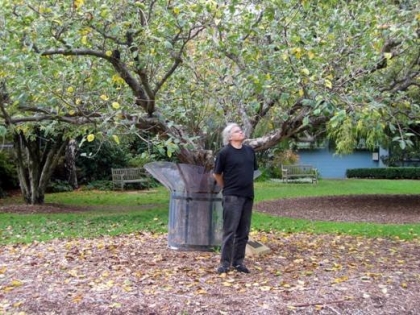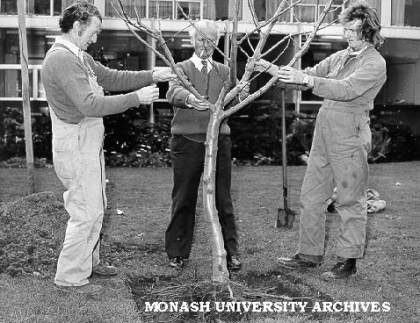Waiting for the apple to fall
by Burkard Polster and Marty Ross
The Age, 25 October 2010

The next time you are looking for some mathematical inspiration, head out to Monash University’s Clayton campus. There, you will find the Newton apple tree.
That Newton? That tree? Yes, Monash indeed has a tree linked to the famous story of Sir Isaac Newton and his discovery of gravitation. But no, it is not a case of some fanatical Aussie mathematicians abducting Newton’s tree.
First, we must qualify the myth: it is definitely not the case that Newton hit upon the concept of gravitation after being whacked by a falling apple. It is also misleading and disrespectful to reduce Sir Isaac’s years of intellectual struggle to one moment of genius.
But there is also truth to the story. Newton did relate that it was while pondering in a garden that he made a critical breakthrough: he realised that the force that makes objects fall might also be acting upon the Moon, and that this may explain the Moon’s orbit. And, in more than one telling of the story, it is a falling apple that inspired Newton’s thoughts.
So, there probably was a Newton apple tree, and there are actually a number of trees competing for the honour. The strongest claim by far is for the apple tree that grew at Woolsthorpe Manor, Newton’s birthplace. This grand old tree toppled over in a storm in 1816, with part of it then being made into a chair. However, the tree apparently re-rooted and still happily survives.
After Newton’s death, the owners of Woolsthorpe Manor transferred cuttings of the tree to Belton Park, Lincolnshire, a few miles away. From there, cuttings were later transferred to the National Fruit Research Station in East Malling, Kent.
There are now many supposed Newton trees, all claiming to be direct descendents of the original. However, recent DNA fingerprinting has revealed many of these trees to be impostors. We are happy to report that Monash’s tree is indeed a direct descendent of the likely original Newton tree, via the East Malling stock.
The Monash tree was planted in 1972, unlabelled and situated in a secluded corner of the Engineering courtyard. Apparently there had been fears of vandalism, although it’s not clear from whom: perhaps some rioting fans of physicist Robert Hooke, Newton’s fierce rival? In any case, the tree was then moved to its current location in 1975. Below is a photo, showing curator John Cranwell and his staff lovingly carrying out the transplantation.

Have you ever seen an apple drop from a tree? Neither have we. But we did surreptitiously sample one of the apples from the Monash tree. The tree is a variety known as Flower of Kent, and our sampling suggested why Newton may have left the apples undisturbed, to drop on their own: Flower of Kent apples taste terrible! They may be great apples for inspiring genius, but they are pretty much inedible.
Puzzle to Ponder: Feel free to suggest solutions in the comments section. Please also email us if you wish to be added to our email list.
Sir Isaac is making an urgent delivery of apples: three huge, inspiring apples. He comes to a rickety bridge. The bridge can carry Newton and two of the apples, but the weight of the third apple would be too much. In a flash of brilliance, Sir Isaac decides to juggle the three apples while crossing the bridge. He reasons that one of the juggled apples will always be in the air, and that the bridge can take the weight of the other two apples. Is Sir Isaac being a genius, or will he and the apples and the bridge all collapse into the water below?
Burkard Polster teaches mathematics at Monash and is the university's resident mathemagician, mathematical juggler, origami expert, bubble-master, shoelace charmer, and Count von Count impersonator.
Marty Ross is a mathematical nomad. His hobby is smashing calculators with a hammer.
Copyright 2004-∞ ![]() All rights reserved.
All rights reserved.